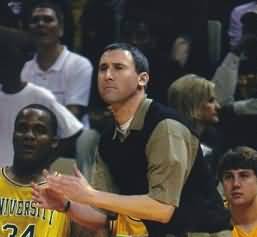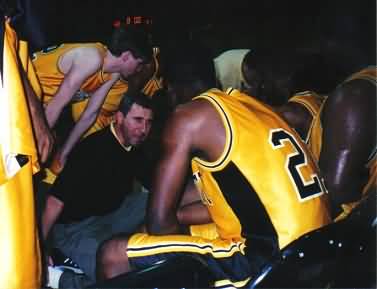Concepts for Playing Fast - Score Early and Often
- by Ari Fisher, Senior Instructor: LSU School of Kinesiology
The Coach’s Clipboard Basketball Playbook
Disclosure: This page contains affiliate links, which means that Coach's Clipboard receives a small commission (at no cost to you) if you make a purchase using these links.
Ari Fisher has coached on all levels except professionally. He started his career as the third assistant at LSU during the tenure of Dale Brown. He was on staff for four seasons; two as a GA and two as restricted earnings coach from 2003-06.
Coach Fisher was also the Head Boys' Basketball Coach and Associate Athletic Director at University Lab School from 1997-2008. His teams won Louisiana High School Class AA State Championships in 2002 and 2004. He was selected district coach of the year four times (1998, 2002 – 2004) and state coach of the year in 2004. His 2004 team finished ranked # 17 nationally.

Coach Ari Fisher
Afishe@lsu.edu or af2002004@gmail.com
During my career I was privileged to have coached at least 50+ teams at many levels: elementary, middle school boys, middle school girls, freshman, JV, Varsity, AAU, summer league teams of kids from different schools, Junior College, and Division I basketball. Similar to every other coach, during years on the sideline I developed philosophies ranging from pre-game routines, to academics, to style of play. Amazingly, I still hold my first basic premise from age 12 of how I believe basketball is best played based on three simple concepts.

Coach Ari Fisher
The team taking the most 'best' shots wins.
There exists a caveat as every coach has a different definition of what constitutes a 'best' shot depending on comfort level. Any coach who attempts to institute a philosophy outside their personality is doomed to mediocrity at best. My definition of a good shot is as follows: ideally uncontested as close to the basket as possible depending on time and score of a game and whether a teammate is open for an easier shot.One idea emphasized to players is we would rather throw the ball at the goal than out of bounds, to the opponent, or dribbling off a player's foot. Successful creation of open shots means we must advance the ball via the pass as fast as possible to improve chances of finding someone uncontested in a good area to score.
Some teams frustrated mine by being slow, reversing the ball from side to side patiently waiting for a perfect shot desired by the coach. Usually, a possession might be more than one or several minutes. We had huge problems against that system yet over time realized an unintended advantage. To win, a meticulous team must avoid any turnovers because it limits total number of shots taken. In some extreme circumstances if our opponent made every attempted shot during the game with no turnovers, they still would not have scored enough points to win. I lean liberal on a mythical shot selection continuum.
Of course, the correct kids should be taking a majority of shots and no player may hoist a shot not practiced. A game is not for personal skill experimentation. The Don Meyer term 'sureness', especially when shooting or passing, is a theme we discuss. Even during games where nobody is shooting well, if shots are uncontested and close to the goal - the highest possible odds for success will remain.
A team in superior physical condition wins.
The danger of this idea is some coaches believe it means being in better condition than one specific opposing team. The ideal circumstance is when your team attains its collective best physical condition without consideration of any opponent. Sprint the court every offensive possession, advance the ball quickly via passing and only dribble primarily for 'rim attacking'.Beginning in middle school I attended five star summer basketball camp. Each evening the famous 'station 13' was following dinner prior to league games. 'Station 13' was voluntary but many campers attended because a big name coach was teaching for an hour. Unusually, one day a young, unknown coach with the last name Calipari (perhaps you have heard of him) was explaining fast break decision-making. His primary rule was refreshingly simple and still a staple for my personal x's and o's philosophy.
He demonstrated how everyone with the ball has an imaginary direct line to the basket. He believed the person with the ball advances and if nobody directly steps in the way then they attack the rim. Should someone obstruct the clear lane to the basket then the person with the ball jump-stops under control and passes to the next open teammate who repeats the process; "in my lane, out of my lane" was the catch phrase used. It stuck with me and while gaining advanced ideas during my coaching maturation and being exposed to different philosophies, it remains the rule for a fast break system largely used during my entire career.
The most important element for playing fast is ball advancement starting with an initial outlet pass. If even a half second slow, the system stalls. If the outlet is fast and accurate consistently, the system is lethal. The most common mistake made by players is poor speed securing the ball from the net after a made shot (even a foul shot). A coach could designate one specific player to jump; snatch the ball out of the net; not waiting for it to fall into his hands. Other coaches might train everyone how to outlet because a certain situation may prevent the designated player from being in position to throw the fast outlet.
A drill for practicing outlet speed is a variation of the famous Mikan drill. Add a rule for everyone to jump and get the ball out of net with two hands. Another drill starts with the player under the rim who must take two large steps for turning and releasing an accurate outlet pass. Sprinting (not a casual walk or jog) out of bounds is paramount. Practicing footwork regarding the steps, turning on the second step while preparing the ball for release is helpful. Accurately releasing the outlet to an open man, either the traditional point guard who can find a teammate open, or perhaps someone already sprinting who clearly beat the defense, will result in a lay-up.
The pass should be overhead (not behind the head) or a baseball pass released from just behind the ear (not a full wind up). Passes thrown with thumbs pointing down to the floor on release will eliminate the ball to float upwards, allowing defense to retreat and defend. When the inbound pass is to a point guard, ideally it should be as deep toward mid court as possible. If there is no open lane runner, the point guard still advances at full speed using a maximum of two dribbles (depending on the depth of the outlet) looking to find an open teammate; a term we call 'pitch ahead'.
Every possession must possess quick ball advancement, as this puts pressure on the defense even if they are initially getting back. This also allows for easier execution against a full court press because an opponent does not have time to set the proper alignment. Opponents might stop transition for a while but consistently attacking will eventually cause breaking points and your team makes a mini-run for five to six points forcing the opponent to use a time out.
Three or four mini runs during a game will methodically provide a twenty+ point spread as superior conditioning stresses the opponent through an entire game. It is necessary to emphasize constant pressure on every offensive possession even if players become frustrated with lack of open teammates or no layups. Be alert because frustration might lead to turnovers (the Kryptonite for a fast break) and a time out will be needed to settle their minds and reassure them that with patience it will work.
All fundamentals must be successfully executed at game speed in the full court.
This idea is most successful with short but intense practices. The first 25 to 30 percent is devoted to dribbling, passing, pivoting, competitive situations such as 2 on 1, 3 on 2, and 4 on 2, contested lay ups, and catching with two hands on a two foot jump stop - simple fundamentals needed for any offensive system. We prefer everything practiced in a full court situation sometimes against more than five defenders.Fundamental work additionally allows for ability to play half court offense or defend properly for long possessions. The other 75% of practice is devoted to sprinting as much as possible, outlet passing off a make or miss, shooting within fast break situations, offensive rebounding, special situations (last second plays, out of bounds, playing overtime, being behind and having to foul), more contested lay ups and foul shooting after sprinting every five or so possessions.
I am poor at coaching intricate strategy. My hope for every game is the opponent becomes fatigued thus slowing down and playing sloppy - not forcing me to win based on game management or general coaching strategy. During my high school coaching career, teams were 101-1 when we scored 70 or more points and 120-116 when we did not. I am a type 'A' personality, quite aggressive, thus my coaching philosophy is a reflection of it. Anyone can play fast because anyone can perfect simple fundamentals and be in superior physical condition. The entire system relies on attitude and effort, both completely under the control of each player.
In conclusion, my passion other than coaching/teaching is thoroughbred horse racing. A fundamental truth within racing is 'pace makes the race'. Forcing an opponent to play at an uncomfortable pace (which most of the time is faster than they want) will dramatically enhance chances of winning.
Related pages: